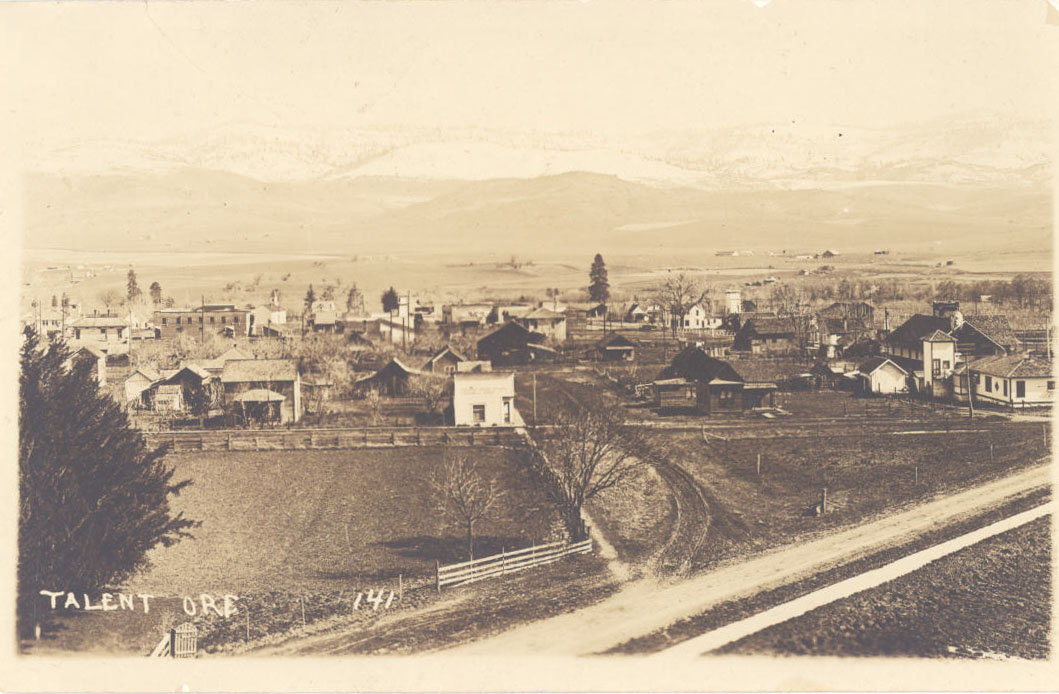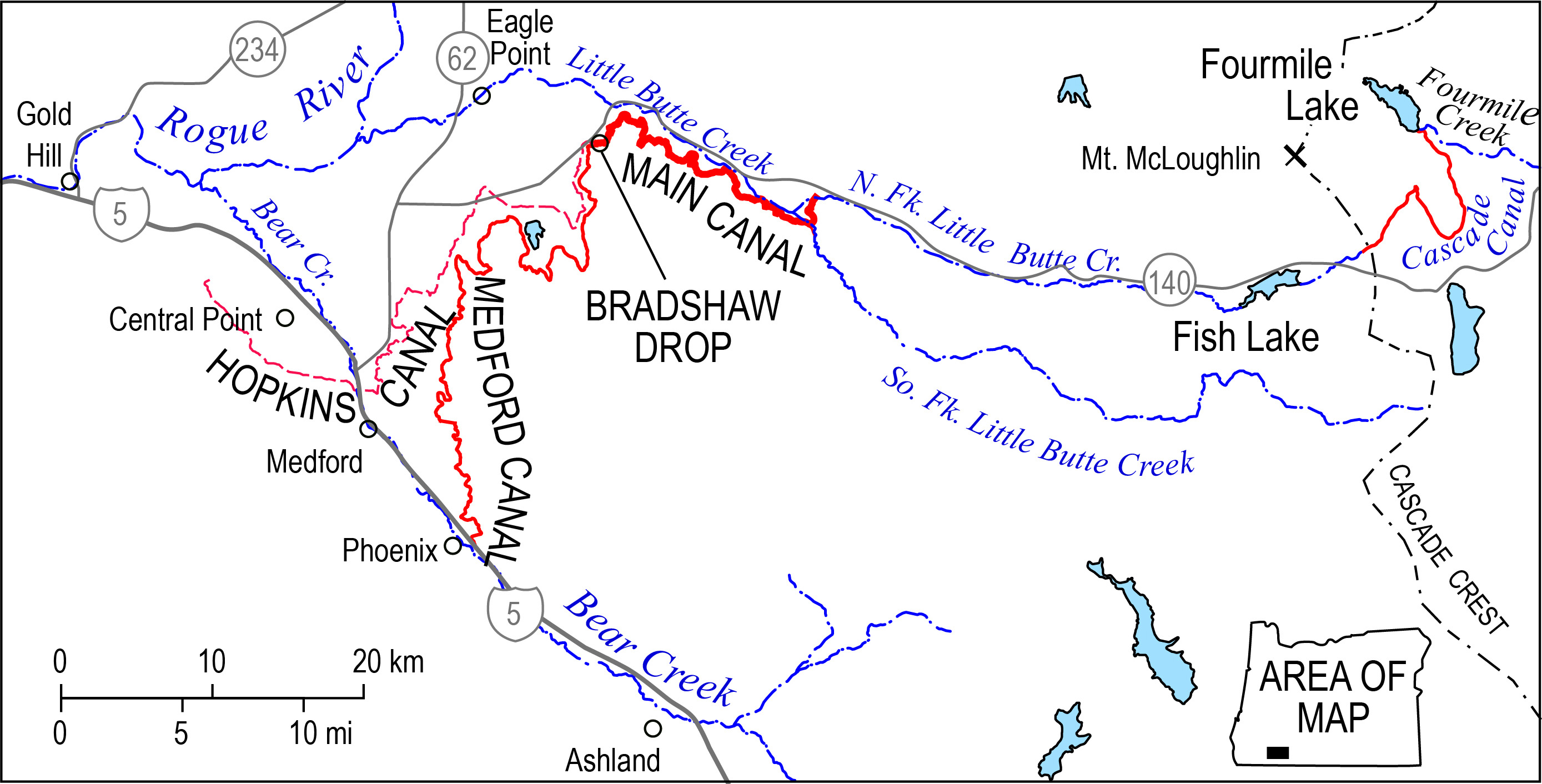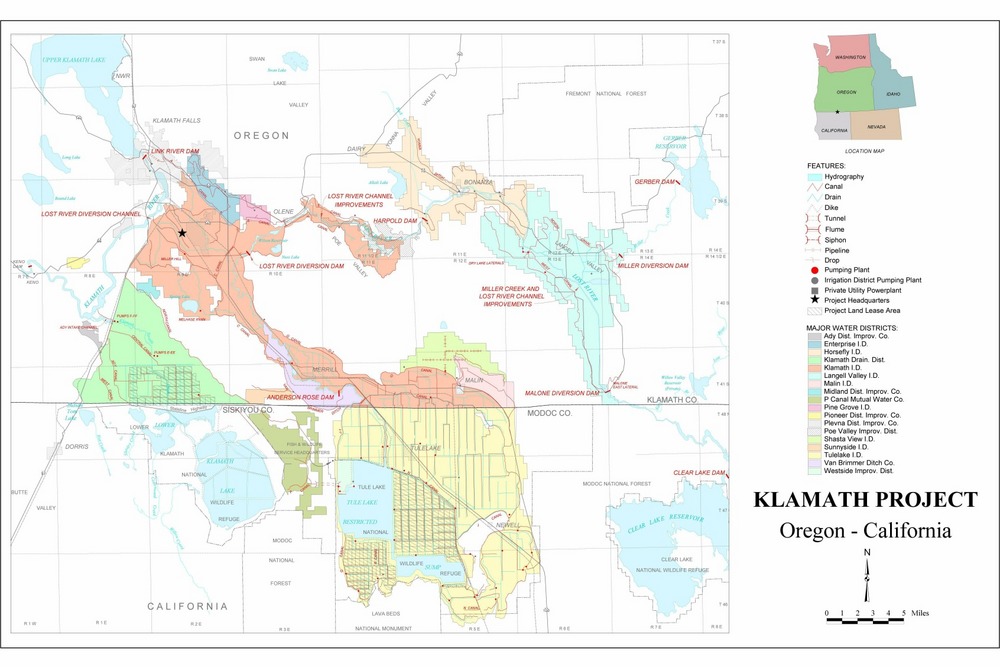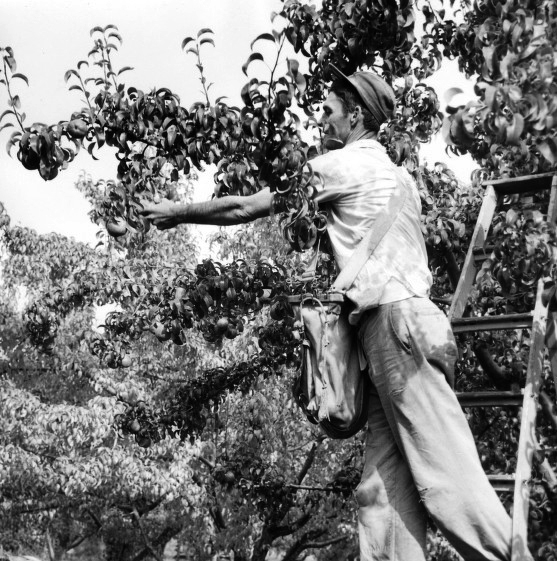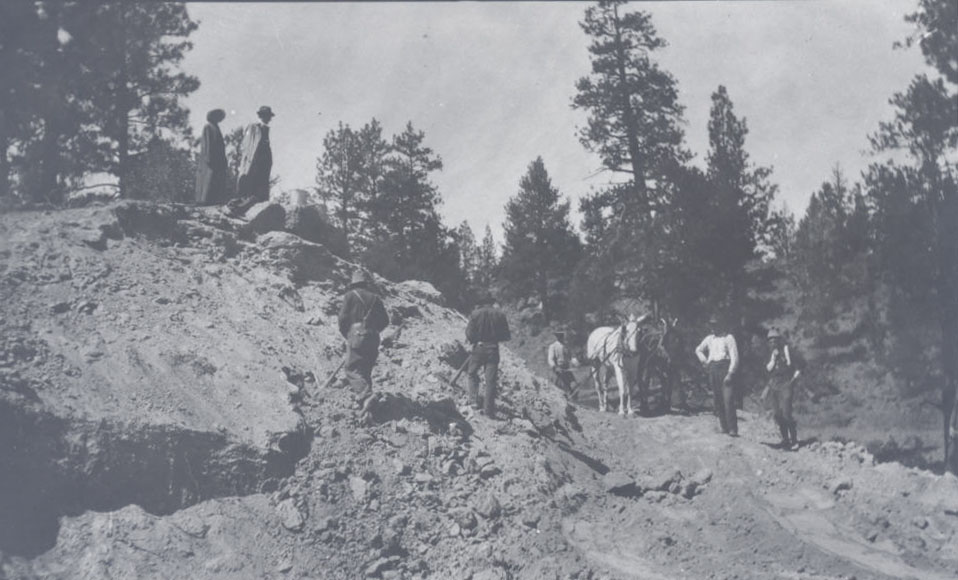Irrigation in the Hood River Valley, about sixty miles east of Portland on the Columbia River, was once a matter of supplementing nature. During the mid-nineteenth century, orchardists could grow fruit without additional water; but as the dense, timbered land in the valley was cut over (logged), irrigation was a way to ensure the growth of the local fruit industry. Unlike most other agricultural areas, however, irrigation stayed local, following the establishment of the orchard industry instead of being its catalyst. Through cycles of constant improvement of its irrigation systems, the Hood River Valley became a famous fruit-producing area.
In 1854, Nathaniel Coe arrived in the valley where the City of Hood River is today. He cleared some land and harvested his first crop of apples in 1859. In 1886, the first commercial apple orchard was started by Peter Mohr, who planted 400 trees on the east side of the Hood River Valley. During the 1890s, reports of the bountiful orchards attracted immigrants from Finland and the East Coast, who came to the valley to buy land and plant orchards. They were followed by Japanese immigrants in the early 1900s, who hired on to clear land as a step toward acquiring property.
The first irrigation ditch in the Hood River Valley was dug by the Water Supply Company in 1874, but what became known as the “big ditch” was not completed until 1897. The eleven-mile-long main canal was built by the Valley Improvement Company, started by Jeremiah F. (Frank) Davenport to irrigate the west side of the valley by diverting water from the Hood River. The big ditch “changed the Hood River Valley almost overnight from a poverty pocket to a land boom,” David Burkhart and Ruth Guppy wrote in 2007. It was also a catalyst for more irrigation in the valley. As with many early irrigation projects in the West, it was the water users themselves who made that happen.
By 1907, irrigation systems were in place, linked to the Hood River forks and the many creeks and streams in its watershed. The Hood River Basin Partnership reported, “there were 349,435 apple trees, 9,152 pear trees, 4,527 cherry trees, and 7,180 peach trees in the valley.” By 1910, the twenty-two-mile-long Mt. Hood Railroad had been completed to transport carloads of fruit from the orchards and fields. Unlike in other parts of Oregon, the Hood River Valley never had a federal irrigation project. Valley farmers were an independent lot, and unlike other fruit-growing districts in Oregon and the Pacific Northwest, the Hood River Valley already had adequate precipitation. Local irrigation was developed to enhance existing agriculture rather than to establish new areas to grow fruit trees.
The East Fork Irrigation Company’s canal system was constructed in 1895–1905 on the east side of the valley, where farmers built canals in discontinuous sections in order to pay for their stock in the company. But the canals were “not the same width in all places” and were reconstructed to be uniform in width, grade, and bank. From 1909 to 1912, the Dee Irrigation and Power Company system was built by David Eccles’s Oregon Lumber Company to develop 2,000 acres of land the lumber company had logged near Dee. The six-mile-long ditch was surrounded by small tracts of lands rented by Issei and Nisei farmers who grew strawberries, pears, and apples in Dee, Odell, Parkdale, Pine Grove, and Oak Grove.
The development of the irrigation systems was a mostly local affair, with citizens from around the county doing the construction and, later, managing with a local board of directors (an exception was the Dee Irrigation and Power Company, which was private). Hood River orchardist Charles R. Bone, for example, was a contractor for the East Fork Irrigation Company who oversaw construction of the system and held the mortgage of the EFIC system until it was paid off in 1906.
During the early years, canals were constructed of earth or had wooden flumes to cross a deep ravine or stream. During the World War I era, concrete flumes or Armco metal Lennon-type flumes were used. In 1923, on the Farmers Irrigation Company system, a 210-foot-long tunnel in the main canal replaced 400 feet of flume that was consistently washed away by floodwaters. During that period, smaller ditches were piped with wooden stave or iron, and diversion dams and headworks built of logs or earth were replaced with concrete headworks with metal gates.
Irrigation companies reorganized and changed their names because of financial woes during the early twentieth century. After 1913, many irrigation companies were reorganized when Oregon passed laws governing the formation of districts. The changes were made after a populist movement of landowners took control of privately operated systems so they would operate more effectively, increasing cooperation and updating gravity irrigation systems that had not been maintained.
In 1913, the East Fork Irrigation Company became the East Fork Irrigation District, and new owners set out to reconstruct the poorly built and engineered irrigation system. The company focused on the 7-mile-long Main Canal and three laterals (Odell, Neal Creek, and Middle), totaling 21 miles, and 400 miles of sublaterals and distributing flumes. Farmers and ranchers purchased the Dee Irrigation and Power Company system from the Oregon Lumber Company in 1922 and renamed it the Dee Flat Irrigation District.
By 1926, practically all of the valley’s irrigable areas—29,694.82 acres—were organized into districts: East Fork Irrigation District, Middle Fork Irrigation District, Hood River Irrigation District, Farmer’s Irrigation Company, Dee Irrigation District, Mount Hood Irrigation District, and Glacier Irrigating Company. The projects stretched from the upper to the middle valley and to the lower west side. Originally, all of the districts were privately owned. The Farmer’s Irrigating Company became an irrigation district in 1965 when the 1964 flood damaged their system so badly that it became necessary to get federal funds for repairs.
During the 1920s and 1930s the systems mostly stayed the same in their original design of open canals, but there was a big push after World War II to improve aging systems with more and better piping. Those kinds of improvements continue into the twenty-first century for water conservation. Throughout the irrigation reconfigurations, Hood River Valley orchards have maintained their importance to Oregon’s fruit economy, especially for pears, which were made Oregon’s state fruit in 2005—a bill that was cosponsored by Rick Metsger, the representative for Hood River.
-
![]()
Hood River Valley orchards.
Oregon Historical Society Research Library, photo file 522
-
![]()
Irrigating a strawberry field, Hood River Valley,.
Oregon Historical Society Research Library, Orhi97646
-
![]()
Irrigation Districts in Hood River County.
Courtesy Jake Edwards, ArcGIS -
![]()
Irrigation in Hood River Valley.
Oregon Historical Society Research Library, 7847, photo file 22
-
![]()
Irrigation Flume, over the Hood River, 1910.
Courtesy Hood River County History Museum, Benjamin Gifford, Hood River Commercial Club -
![]()
Hood River Valley orchards.
Oregon Historical Society Research Library, 15848, photo file 522
-
![]()
Irrigation Ditch, Hood River Valley.
Courtesy Hood River County History Museum, Apple Growers Association -
![]()
Farmers Irrigating Co. buildings and flume, 1948.
COurtesy Hood River County History Museum, -
![]()
Hood River Valley orchards.
Oregon Historical Society Research Library, 14774, photo file 522
-
![]()
Blossoms in Hood River, 1953.
Oregon Historical Society Research Library, Al Monner news negatives; Org. Lot 1284; Box 44; 2101-1
Related Entries
-
![Beeson-Robison Ditch]()
Beeson-Robison Ditch
Located south of Talent, in southwest Oregon, the Beeson-Robison Irriga…
-
![Community of Dee]()
Community of Dee
Dee refers to a lumber-mill town located on the Middle Fork of the Hood…
-
![Crooked River Project]()
Crooked River Project
In 1956, with the help of Oregon senators Wayne Morse and Richard Neube…
-
![Fish Lake Canal Company]()
Fish Lake Canal Company
The Fish Lake Water Company was organized in Medford in 1898 to create …
-
![Hood River (city)]()
Hood River (city)
Situated in the Columbia River Gorge about sixty miles east of Portland…
-
![Klamath Basin Project (1906)]()
Klamath Basin Project (1906)
When trapper Peter Skene Ogden first saw the Upper Klamath River Basin …
-
![National Reclamation Act (1902)]()
National Reclamation Act (1902)
When Congress passed the National Reclamation Act in 1902, the measure …
-
Pears and the pear industry
European pears (Pyrus communis) thrive in the temperate climate of the …
-
![Tumalo Irrigation District]()
Tumalo Irrigation District
The Tumalo Irrigation District delivers water from Tumalo Creek, supple…
Related Historical Records
Map This on the Oregon History WayFinder
The Oregon History Wayfinder is an interactive map that identifies significant places, people, and events in Oregon history.
Further Reading
"Big System Completed." Hood River Glacier, April 1, 1915, p. 1.
Burkhart, David J., and Ruth Guppy. It All Began with Apple Seeds: Growing Fruit in the Hood River Valley 1880-1980. Bend, Ore.: Maverick Publications, 2007.
"Dee Irrigation Canal, 6 Miles Long, Is Done." Oregon Daily Journal, July 8, 1912, p. 9.
"Dee Irrigation District Formed." Hood River Glacier, June 22, 1922.
Harkness, Frank. “Irrigation Increases Hood River Apple Crop.” The Highway Magazine 10.9. (1919).
"Irrigation in the Hood River Valley." The Hood River News, October 22, 1926, p. 14.
"Japanese At Dee, Or., Uses Hands, Gets Rich." Oregon Daily Journal, July 16, 1912, p. 10.
"Orchards Are Growing." Morning Oregonian, June 10, 1910, p. 18.











